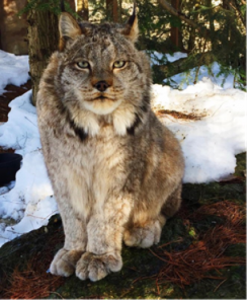April 28, 2017 | Schnecksville, Pa – Lehigh Valley Zoo is happy to announce the birth of another scimitar-horned oryx, a critically endangered species of antelope still listed as extinct in the wild. The mother and male calf are doing well and have spent some time off-exhibit to bond with each other and to allow for monitoring by our Animal Care and Veterinary team. The as-of-yet unnamed youngster was born on April 9th. The calf will be introduced to Zoo Visitors this Sunday April 29th as he and mom will go on exhibit together for the first time.
 “This calf is the seventh born at the Lehigh Valley Zoo and is the fourth calf born to her mother.” Said Zoo CEO/President, Melissa Borland “Until recently, scimitar-horned oryx were considered extinct in the wild. We are honored to be part of a program that is re-populating this species.”
“This calf is the seventh born at the Lehigh Valley Zoo and is the fourth calf born to her mother.” Said Zoo CEO/President, Melissa Borland “Until recently, scimitar-horned oryx were considered extinct in the wild. We are honored to be part of a program that is re-populating this species.”
Every birth is crucial to ensuring the survival of the species. Lehigh Valley Zoo participates in the scimitar-horned oryx Species Survival Plan (SSP) program, a cooperative effort among Association of Zoos and Aquariums (AZA) accredited facilities. The scimitar-horned oryx SSP is part of the ongoing reintroduction plans to return these majestic antelope to their historic range. Once widespread in northern Africa, the scimitar-horned oryx was hunted to near extinction for its trophy horns, tough hide, and meat. Lehigh Valley Zoo joined with 52 other zoos to take part in a project organized by the Species Survival Plan, nurturing births from the herds residing in the zoos. In March of 2016, the first 25 oryx were released to the Ouadi-Achim Faunal Reserve. Following additional releases, there are now 90 oryx, born in zoos and conservation centers under this project, in Chad, Africa. The oryx released back into the wild are monitored by the team in Chad. The project reports the oryx are thriving in the wild and even had a few wild births.
On the heels of the arrival of the new calf, the Lehigh Valley Zoo will soon be sending a female oryx, born to parents at the Zoo in 2016, to another conservation breeding center as part of the recommendations by the scimitar-horned oryx Species Survival Plan. This young female will join a breeding herd of scimitar-horned oryx to be a crucial part of the ongoing efforts to protect the species from extinction. The Lehigh Valley Zoo participates in over 20 SSP programs.
Lehigh Valley Zoo is located at 5150 Game Preserve Road, Schnecksville, PA 18078.
# # #
About the Lehigh Valley Zoo:
As a member-supported non-profit organization, Lehigh Valley Zoological Society was founded in 2004, but as a treasured community landmark, the Zoo’s history spans over a century. Founded in 1906 by General Harry C. Trexler, a local industrialist, the Lehigh Valley’s Trexler Game Preserve has educated and entertained more than five million people.
Accredited by the Association of Zoos and Aquariums (AZA), the Lehigh Valley Zoo hosts year-round, family-friendly events and activities, educational programs, and camps. With a mission to create a safe, engaging and enlightening wildlife experience for guests of all ages, the Zoo demonstrates leadership in the cultural, scientific and conservation communities. To learn more about Lehigh Valley Zoo, we invite you to visit our website, www.lvzoo.org, or follow us on Facebook.






 Schnecksville, PA, March 6, 2018: Lehigh Valley Zoo announced that the horrific storm on Friday, March 2nd severely damaged the entrance sign to the Lehigh Valley Zoo. Understandably, it will be costly to replace the sign. The damage comes at an awkward time in the zoo’s plans and finances. The zoo had planned to relocate and redesign the entrance to be ADA accessible by the close of 2018. Spending scarce funds to replace the damaged sign only to relocate the entrance six-nine months later is not a prudent use of resources. “We are disheartened that our sign was destroyed.” Said Melissa Borland, President and CEO of Lehigh Valley Zoo, “On the other hand, it gives us an opportunity to share our long-term goal of creating a disability-friendly entrance. With the community’s help, we hope to accelerate our timeline for relocating our entrance.”
Schnecksville, PA, March 6, 2018: Lehigh Valley Zoo announced that the horrific storm on Friday, March 2nd severely damaged the entrance sign to the Lehigh Valley Zoo. Understandably, it will be costly to replace the sign. The damage comes at an awkward time in the zoo’s plans and finances. The zoo had planned to relocate and redesign the entrance to be ADA accessible by the close of 2018. Spending scarce funds to replace the damaged sign only to relocate the entrance six-nine months later is not a prudent use of resources. “We are disheartened that our sign was destroyed.” Said Melissa Borland, President and CEO of Lehigh Valley Zoo, “On the other hand, it gives us an opportunity to share our long-term goal of creating a disability-friendly entrance. With the community’s help, we hope to accelerate our timeline for relocating our entrance.” The current entrance to the zoo, located at the crest of a steep hill that, although picturesque, is difficult for those with wheelchairs, canes, and strollers to negotiate. To address the obstacles created by the hill, the zoo planned to relocate the entrance to the west side of the zoo in late 2018. The land on west side of the zoo is flat, and an entrance gate at that point of the zoo has visitors entering across from the lively and active North American river otters with its stadium seating. Along with the flat surface which is better for those with mobility challenges, the new entrance provides access for wheelchairs. Additionally, it includes space for a facility for charging and storing mobile scooters for those needing support to traverse the zoo property. An added benefit of the relocated entrance is that it will be safer for those with strollers and toddlers learning to walk. “We want the Lehigh Valley Zoo to be inclusive of all members of our community.” Added Melissa Borland, “This relocation will insure the entrance to the zoo is ADA accessible.”
The current entrance to the zoo, located at the crest of a steep hill that, although picturesque, is difficult for those with wheelchairs, canes, and strollers to negotiate. To address the obstacles created by the hill, the zoo planned to relocate the entrance to the west side of the zoo in late 2018. The land on west side of the zoo is flat, and an entrance gate at that point of the zoo has visitors entering across from the lively and active North American river otters with its stadium seating. Along with the flat surface which is better for those with mobility challenges, the new entrance provides access for wheelchairs. Additionally, it includes space for a facility for charging and storing mobile scooters for those needing support to traverse the zoo property. An added benefit of the relocated entrance is that it will be safer for those with strollers and toddlers learning to walk. “We want the Lehigh Valley Zoo to be inclusive of all members of our community.” Added Melissa Borland, “This relocation will insure the entrance to the zoo is ADA accessible.”









